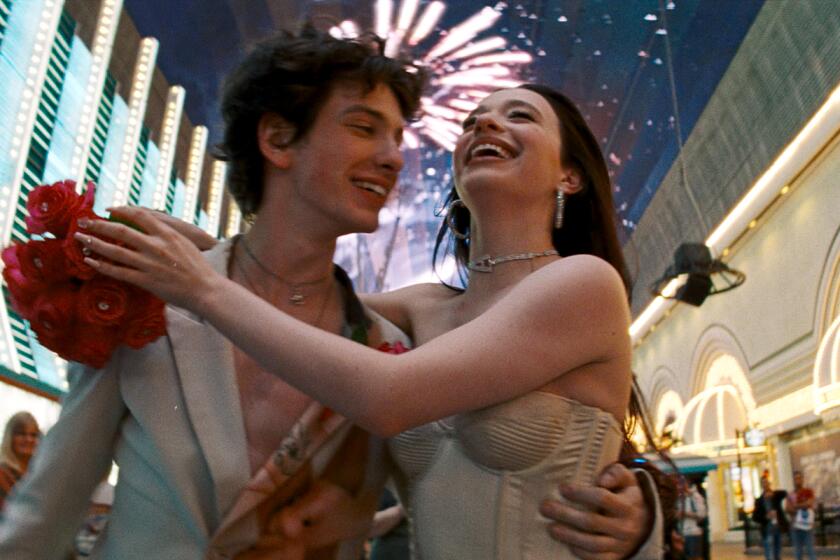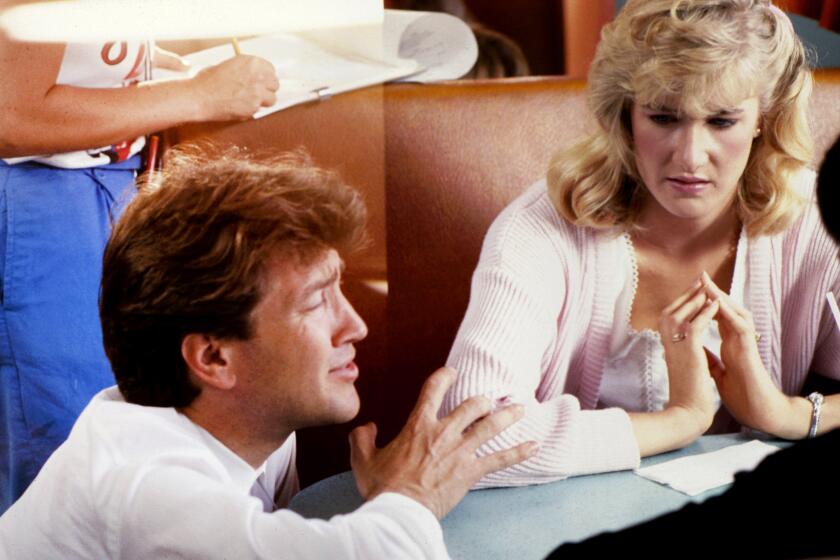COMMENTARY : Murphy & Pryor’s Star Trek : Movies: For all the star quality Eddie Murphy and Richard Pryor bring to the screen, their comic talents seem to have taken a wrong turn.
- Share via
“Harlem Nights” is the first movie to co-star Eddie Murphy and Richard Pryor. Watching the sorry, unfunny mess that has resulted is like witnessing a highly touted heavyweight title bout that inexplicably turns into a pat-a-cake session between cruiserweights. Even those of us who have just about given up on Murphy hoped the pairing with Pryor would snap him to attention. But it’s been a long stretch since either Murphy or Pryor has thrilled audiences with anything more than their star power.
There was a time--say, seven or eight years ago--when such a confab would have raised the rafters. Murphy began his four-year stint at “Saturday Night Live” during the 1980-81 season, and his appearances on that show, with his impersonations of pimps, jailbirds, Gumby, Buckwheat and Bill Cosby, are still his comic high point. He could create characters that had the whole country talking about them the next day. Pryor, of course, had a thriving if uneven movie career in the early ‘80s. His glory, however, was his stand-up comedy films, particularly the 1978 “Richard Pryor Live in Concert” and the 1982 “Richard Pryor Live on the Sunset Strip.” They were the movies in which Richard Pryor could be Richard Pryor.
In the intervening years, Murphy has become a major movie star largely at the expense of what made him a TV star. He has moved away from the quicksilver, revue-sketch humor and the edgy playfulness of his “SNL” days and turned himself into a commodity. His comic facetiousness has turned stone-cold. Whereas he once professed his idol to be Richard Pryor, his movies suggest another deity: Sylvester Stallone.
Murphy is a movie star because his films make fortunes, but is there anything stellar about his work as a ‘30s nightclub dandy in “Harlem Nights,” a movie in which his character’s homicidal streak is played for cheap laughs? Is there anything anointed about his work in such films as “The Golden Child,” “Coming to America” or “Beverly Hills Cop II”? His reprehensible 1987 stand-up comedy film “Raw” begins when, leather-suited, he strides on stage amid hoopla not inappropriate to the Second Coming. The film was a real potpourri of hatred. In it, his free-floating hostilities descend on women, gays, whites, blacks--take your pick. To review it was to leave the domain of criticism for psychiatry.
Stardom can sometimes enlarge an actor’s possibilities and bring out what was nascent, and best, in his talents. The reverse seems to have happened to Murphy. In “SNL,” he was part of an ensemble; he was challenged by the other performers. In his movies, starting with his first (and still best) film, “48 HRS,” where he co-starred with Nick Nolte, Murphy has essentially been performing solo. He works with such crackerjack precision that sometimes he doesn’t need anybody else around; he can be his own most appreciative audience.
But Murphy desperately needs to be challenged in the movies. Yet, given the fact that he controls them so completely--he is writer, director and executive producer of “Harlem Nights”--how will that ever happen? His clout has allowed his worst instincts to come through.
Richard Pryor is playing his surrogate father in his new film, but there’s an element of condescension in the casting. Pryor is positioned as Murphy’s wise and cautious mentor, an elder statesman. It’s the kind of “tribute” that’s indistinguishable from neutering.
If Eddie Murphy’s star power has allowed him all too successfully to tincture his films with the poison of his stand-up-comedy attitudes, then Richard Pryor has the opposite problem. His box-office clout has allowed him the opportunity to make a series of marginal movies with virtually no connection to his great stand-up persona. In films ranging from “The Toy” to “Bustin’ Loose” to “Brewster’s Millions,” Pryor has opted for the cushiony comforts of family entertainment. With his pick of writers, directors and co-stars, he has nevertheless willingly led himself into creative oblivion.
It’s never been easy for a volatile talent to score in the movies; the commercial demands of the business are invariably at odds with true subversiveness. But Pryor has the kind of control that might have preserved his rawness on film, not only in his concert movies, but in his dramatic films too. The cuddliness of his screen image is a sick joke. It might seem like a put-on if only Pryor showed some sign that he was in on the con. But he is resignedly bland in his movies; anything malign or threatening has been bleached out.
With an artist as troubled and complicated as Pryor, it’s difficult to assign motivation. Does a film like “Bustin’ Loose,” where he plays a good-natured grump to a busload of kids, represent what Pryor thinks the movies deserve? Does he think such movies represent what he deserves? Obscenity has always been the fuel of Pryor’s art, and these roles can’t accommodate it.
He has never quite given up entirely, though. Bad as it was, his 1986 autobiographical film “Jo Jo Dancer, Your Life Is Calling,” which he also directed, was at least an attempt to scour the treacle from his image. In films like the 1972 “Lady Sings the Blues,” playing Piano Man to Diana Ross’ Billie Holiday, the 1978 “Blue Collar,” where he played a Detroit auto worker, and the 1981 “Some Kind of Hero,” where he played a POW returning from Vietnam, he gave indications of wanting to do more as an actor than just make nice. For years there was talk that he was preparing a biography of Charlie Parker.
The problem may be that Pryor believes that, in order to quell his demons, he can’t draw on anything in his life that means anything to him. In “Live on the Sunset Strip,” talking about his recuperation after his free-basing accident, he says, “Maybe I ain’t funny anymore. Maybe I ain’t hungry at nothing for real in my heart.” But the triumph of that film was that Pryor demonstrated he could be an artist without working up a fount of rage. Pryor has been funnier than he was in that film, but he was never as mysteriously moving, or as fragile.
Actually, Pryor has always been mischaracterized as a riotous comic. He was never really a social-activist crusader; his stand-up riffs exposed racism, but his humor was deeply personal, screwed up, aloof. The Get Whitey agenda of the early ‘70s never quite played for Pryor as it did for the other black comics and actors because Pryor was after private demons, not white demons.
Regarding whites, he went beyond rage and into stupefaction. (That’s what made the scene in “Silver Streak” where he attempts to teach Gene Wilder how to be black such a howl.) His landscape was ultimately interior. He could split himself into an entire gallery of characters: winos, junkies, hustlers, movie executives, ex-wives. He could animate inanimate objects, like, most memorably, his cocaine pipe in “Live on the Sunset Strip.” The only thing Pryor can’t play is normal, and that, ironically, is what he’s set out to be in movie after movie.
The history of black performers in the movie business is such a trail of waste and despair that the ascension of Eddie Murphy and Richard Pryor has symbolic value out of all proportion to their actual achievement. With few exceptions, black actors have only been accepted as stars when they are comics.
This must explain some of Eddie Murphy’s rage. Deprived in his early movies of any love interest with his white female co-stars, straitened into situations where he played the black sidekick joker to white actors, he has overcompensated by shunting his creative energies into a makeover that probably means a lot more to him than it does to audiences. His attempts to promote himself as a stud action-hero with a curdling cruel humor must function as a kind of retribution for him. For some of us, it’s a punishment.
More to Read
Only good movies
Get the Indie Focus newsletter, Mark Olsen's weekly guide to the world of cinema.
You may occasionally receive promotional content from the Los Angeles Times.










